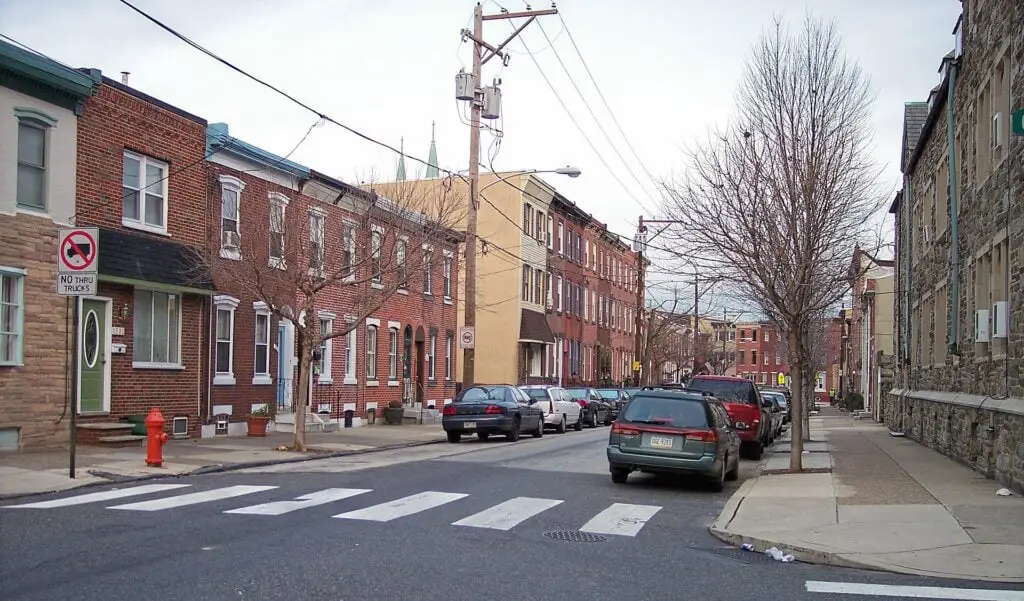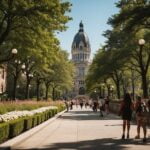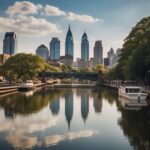Located in northeastern Philadelphia, River Wards is a dynamic Planning Analysis Section characterized by its unique neighborhoods, rich history, distinctive demographics, and noteworthy features. This region, comfortably nestled along the Delaware River, embodies the essence of Philadelphia’s industrious past and vibrant immigrant heritage.
River Wards, an embodiment of the “City of Brotherly Love”, seamlessly fuses the past with the present. From bustling commercial districts to serene residential areas, this section of Philadelphia is a showcase of urban progression, where historical depth coexists with modern vibrancy. Its unique neighborhoods, profound history, diverse demographic landscape, and unique characteristics contribute to the vivid and ever-evolving narrative of Philadelphia.
Neighborhoods
Each neighborhood within River Wards, Philadelphia offers a distinct charm and personality, contributing to the area’s overall vibrancy and appeal. The amalgamation of diverse cultural influences, historical architectures, and local flavors make this region truly distinctive.
Bridesburg
Bridesburg, the northernmost neighborhood in River Wards, boasts a proud industrial past while maintaining a tight-knit, community-driven vibe. Settled predominantly by Polish immigrants during the early 20th century, this enclave is marked by quaint row homes, local eateries, and cultural establishments such as St. John Cantius Church, an architectural testament to the area’s Polish heritage.
The neighborhood is known for its robust community engagement, demonstrated by the array of local festivals, parades, and block parties that occur throughout the year. Bridesburg is also home to Bridesburg Park, a green space nestled by the Delaware River, perfect for residents and visitors seeking leisurely activities.
While still cherishing its industrial roots, Bridesburg is witnessing a steady resurgence. New businesses, modern housing developments, and enhanced green spaces are becoming part of the landscape, promising an exciting future while upholding the neighborhood’s cherished past.
Fishtown
Fishtown, one of Philadelphia’s oldest neighborhoods, is a dynamic area synonymous with contemporary artistic flair, culinary creativity, and vibrant nightlife. It draws its name from its historic role as the center of the shad fishing industry on the Delaware River.
A walk through Fishtown reveals a mix of row homes intermingled with modern constructions, artist studios, independent shops, and local restaurants and coffee houses. The neighborhood’s sense of community is palpable, with residents often gathering in local parks and participating in neighborhood events.
Renowned for its active arts and music scene, Fishtown boasts a plethora of venues like the Fillmore, a leading destination for live music performances. The neighborhood’s progressive transformation while retaining its historical roots creates a fascinating blend of old and new, making Fishtown a must-visit destination within River Wards.
Harrowgate
Harrowgate, a neighborhood that served as a refuge for Philadelphians during the yellow fever epidemic of the 18th century, offers a unique blend of history and modern urban living. The neighborhood is known for its spacious parks, such as Harrowgate Park and Simpson Recreation Center, where residents can partake in various outdoor activities.
Harrowgate is marked by its diverse residential structures, ranging from grand Victorian homes to the more prevalent row houses. Although it has faced challenges, Harrowgate is seeing signs of renewal, with initiatives aimed at community development and the restoration of historic buildings.
Notably, Harrowgate is home to “The Porch Light,” a collaboration between the Philadelphia Mural Arts Program and the Department of Behavioral Health, which showcases a stunning mural and provides art therapy programs to the community. Harrowgate, with its storied past and budding potential, is a neighborhood teeming with resilience and charm.
Kensington
Known as the “Workshop of the World” during Philadelphia’s industrial heyday, Kensington has undergone significant transformation over the years. Today, it’s a bustling urban community known for its vibrant arts scene, eclectic food markets, and unique historical heritage.
Kensington was the heart of the textile industry in the 19th and early 20th centuries. The neighborhood is dotted with converted factories and industrial buildings that now serve as creative workspaces, music venues, and loft-style housing. It also hosts one of the city’s most vibrant arts districts, with a plethora of galleries, studios, and arts-focused organizations, such as the Crane Arts Building.
Despite its urbanized setting, Kensington doesn’t lack green spaces. The neighborhood is home to McPherson Square, a popular park that provides an oasis amidst the cityscape. Kensington continues to evolve while embracing its rich history, making it a compelling blend of the past and present.
Port Richmond
Situated along the Delaware River, Port Richmond has long been a magnet for immigrants, and this cultural diversity is evident in the neighborhood’s food, customs, and community events. The area was initially dominated by the Irish and German, followed by Polish immigrants in the 20th century. Today, their influence can still be seen in the neighborhood’s cuisine, churches, and festivals.
Port Richmond is characterized by row homes, with many dating back to the late 19th and early 20th centuries. The area’s riverfront has also been revitalized in recent years, transforming industrial sites into parks and recreational trails, like the Port Richmond Trail, offering scenic views of the Delaware River.
In the heart of the neighborhood lies the historic Richmond Street, known for its collection of small shops and restaurants that reflect the area’s diverse heritage. From its rich history to its cultural fabric, Port Richmond is a neighborhood brimming with authenticity and community pride.
Olde Richmond
Olde Richmond, often referred to as simply “O.R.,” is a residential neighborhood characterized by charming row houses, art studios, and a close-knit community. Originally a working-class area, it has seen a resurgence of interest in recent years due to its historic charm and relative affordability.
The neighborhood has a unique community vibe with active civic associations, residents often participating in block parties, and local events. It’s also home to several parks, like the Cohocksink Recreation Center, which serve as community gathering spots.
What makes Olde Richmond special is its successful blend of old and new. Classic Philadelphia row homes sit comfortably alongside modern housing, while long-standing local businesses coexist with newer ventures. It’s a neighborhood where tradition and progress harmoniously intersect, offering an inviting living environment in the River Wards district.
History
The River Wards district of Philadelphia, named for its location along the Delaware River, carries a history as deep as the river it borders. Initially populated by Lenape (Delaware) Native Americans, the area was later settled by Swedes and Dutch in the 1600s before coming under British control. Throughout the colonial period, these waterfront neighborhoods served as trading posts and fishing hubs, marking their significance in the area’s early economic development.
The 19th century marked a transformative period for the River Wards, as the Industrial Revolution propelled Philadelphia into becoming one of America’s most significant manufacturing cities. The district’s neighborhoods, particularly Kensington and Port Richmond, became densely populated with factories and mills. Workers were drawn to these industries from across Europe, leading to the establishment of diverse immigrant communities that are still evident today.
During the latter half of the 20th century, the River Wards experienced deindustrialization and economic hardship, similar to other American urban centers. However, in recent decades, the district has seen a resurgence. Historic buildings have been repurposed, waterfronts have been reclaimed for recreational use, and an influx of new residents and businesses have contributed to an urban renaissance. From its early days as a trading hub to its transformation into a vibrant, urban district, the history of the River Wards is a testament to Philadelphia’s enduring spirit.
Demographics
The River Wards of Philadelphia are rich in cultural diversity, a testament to the area’s long-standing tradition of welcoming immigrants from all corners of the globe. This diversity is mirrored in the variety of demographics across its neighborhoods, which host a mix of populations, from long-term residents to newcomers.
The demographic mix largely represents a blend of Caucasian, African American, and Hispanic residents, each bringing unique cultural influences to the community. Neighborhoods like Kensington, once a predominantly Irish neighborhood, is now home to a large Hispanic community. Port Richmond, on the other hand, maintains a strong Polish influence due to a significant wave of Polish immigration in the early 20th century.
The River Wards also host a significant number of younger residents, with a median age slightly below the city average, reflecting the influx of young professionals and students attracted by the area’s vibrant culture and affordability. Moreover, the area boasts a diverse range of family structures, with a balanced mix of single-person households, families, and multi-generational homes, further adding to the demographic richness of the River Wards. This vibrant mix of cultures, ages, and backgrounds adds to the area’s unique and diverse cultural fabric, making it a microcosm of the larger city’s demographic landscape.
Notable Features
The River Wards section of Philadelphia is a treasure trove of architectural, cultural, and natural attractions that showcase the area’s rich history and vibrant community spirit. From historic structures to urban art, and lush green spaces, there’s plenty to explore and experience in this part of the city.
One of the notable architectural features of the River Wards is the abundant presence of the classic Philadelphia row homes. These residential structures, characterized by their brick façades and often colorful front doors, line up the streets of neighborhoods like Fishtown and Kensington, contributing to their distinctive charm and character.
Another defining feature is the Delaware River Waterfront, which offers a stunning view of the river and serves as a hub for recreation and entertainment. Riverfront Park in Bridesburg and Penn Treaty Park in Fishtown are popular spots where locals and visitors alike enjoy outdoor activities and community events.
Artistically, the area is known for its vibrant street art scene. Kensington, in particular, is home to numerous murals that bring color and creativity to its urban landscape. The murals, many of which are part of the city-wide Mural Arts Philadelphia program, reflect the community’s history, diversity, and resilience.
Among cultural features, the River Wards are known for their eclectic dining scene, reflecting the area’s cultural diversity. From traditional Polish cuisine in Port Richmond to hipster coffee shops in Fishtown, the area offers a culinary experience as diverse as its demographic mix.
In essence, the River Wards, with their blend of history, culture, and urban charm, offer a unique Philadelphia experience that is as rich as it is varied, reflecting the spirit of the city in its most authentic form.
Conclusion
In essence, River Wards, Philadelphia, represents a vibrant and essential facet of the city. The remarkable neighborhoods, in-depth history, demographic diversity, and unique features all combine to provide an authentic Philadelphian experience. To gain a broader perspective of Philadelphia’s offerings, refer to “Discovering Philadelphia: A Comprehensive Guide to the City of Brotherly Love”, which provides a comprehensive exploration of the city’s diverse and captivating landscape.






